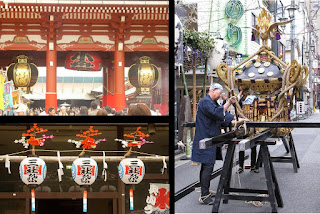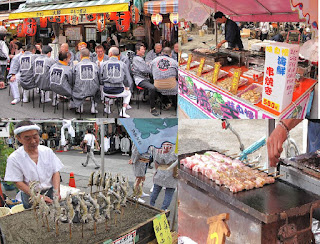.JPG)
16th May 2009, a quiet Saturday at Ueno district where we were staying, just a few minutes walk from Asakusa where the famous
Senso-ji Shrine is located. We started walking from towards Asakusa at 8:30am or so, and as we walk, more and more merry men seems to pass us by, wearing only a japanese overcoat, and their underwear! From a distance, we could hear the sounds of flute, and drums. It was a special day, the day of the
Sanja Matsuri Festival, the welcoming of Spring. The people were preparing for it. Outside the shops and stalls, a lantern was hung with flowers as shown in the photo here. Old Japanese man were busy preparing the "mobile-shrine" as we walked pass them along the alley. And as we approach Senso-ji Shrine, the famous lantern at the
Kaminarimon(雷門) was just about to be raised to half, apparently to allow the "mobile-shrine" to pass through! What a sight!.

We managed to explore the temples of Asakusa before the festival was in full swing around 10am. The processions started with different groups of "mobile-shrine" carrier making their way towards the main temple, chanting as they go along, encourage by the crowds as they walk pass. The loudest claps and encouragement were given to the "mobile-shrine" carried by the children. The procession carried on all the day long, and the ground of the temple was transfered into a huge "pasar-malam" atmosphere as stall lines the way offering traditional Japanese snacks.
.JPG)
The merry men, once they completed the procession, would gather along the many restaurants and have a good beer. Visitors to the festival were seen eating along the food stall. We had a few yakitori as well, each costing Y$500(S$7.50) per stick! But we didn't have any chicken, as the word "Tori" means, we had grilled scallops, clams, and my favourite, grilled pork with leek! Yummy! There was also grilled/smoke fish on a stick which was really really nice!
All in all, it was an eventful day, and I felt totally blessed to have witness a genuine Japanese Festival in action. I think it's a great way to experience a culture when you coincide your trips with a local festival :)
DirectionTake the train to Asakusa Station, and just follow the crowd. We walked there as we were staying at Ueno area :)
Ref:
Yakitori 焼き鳥 やきとり